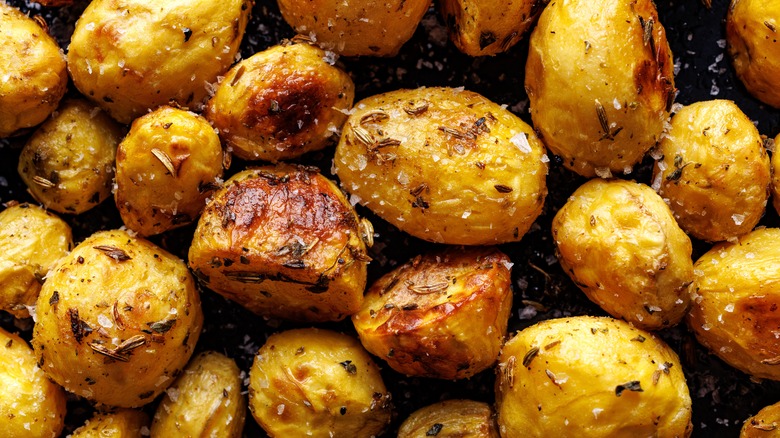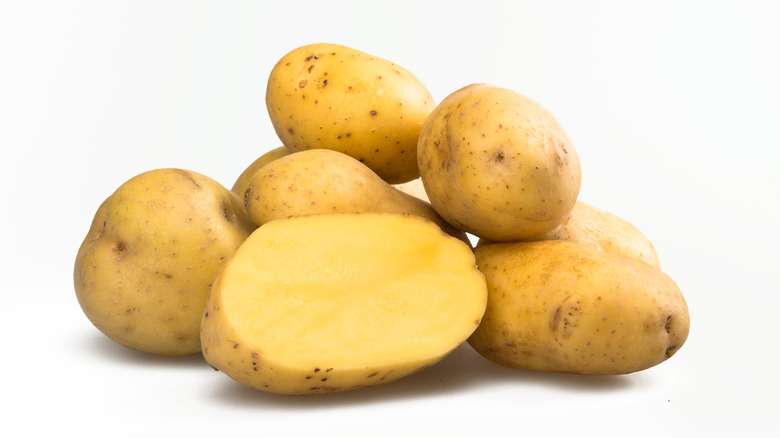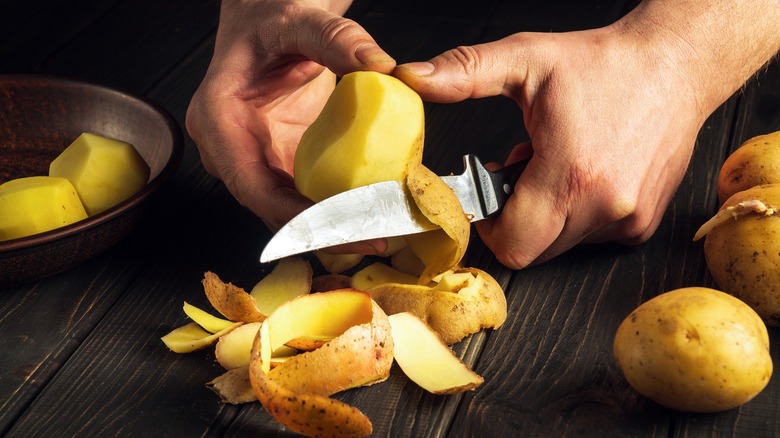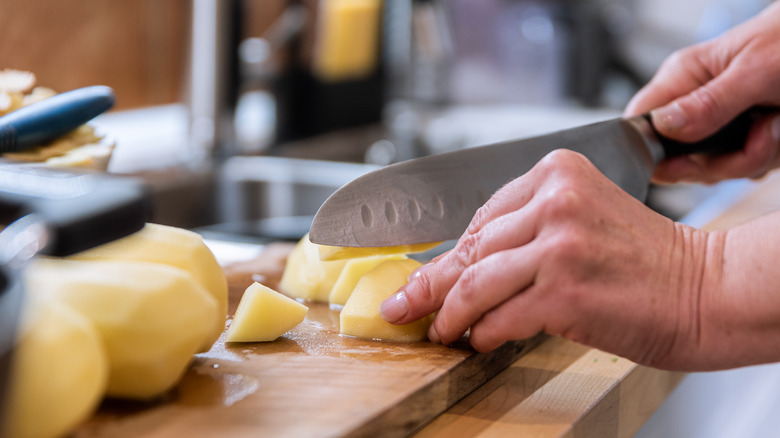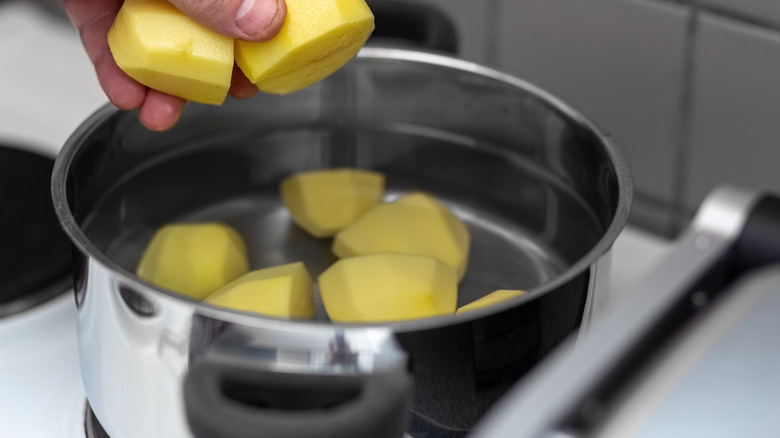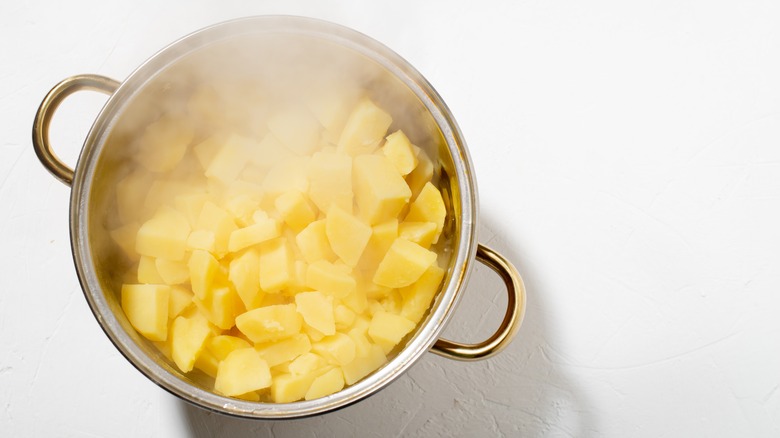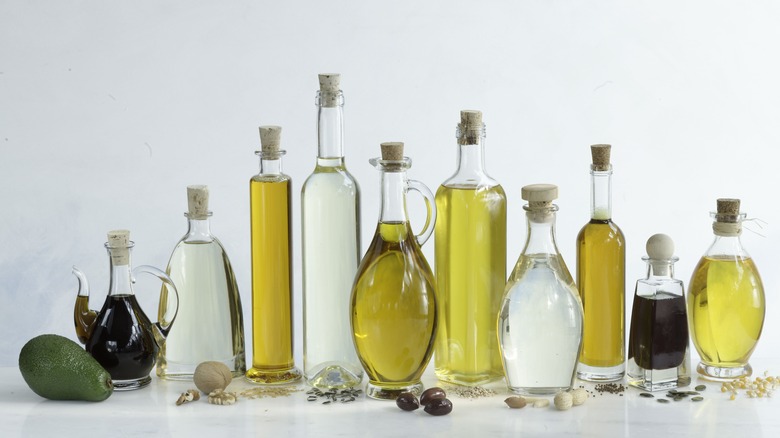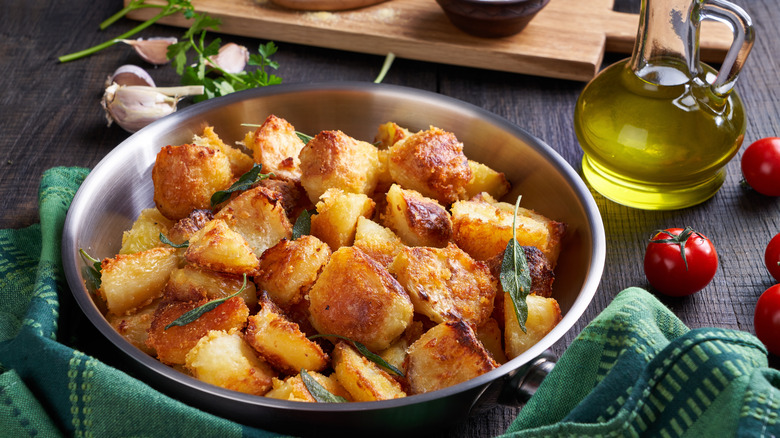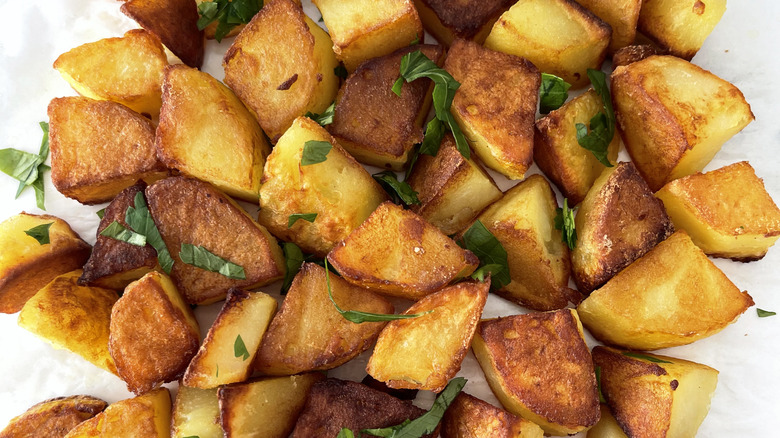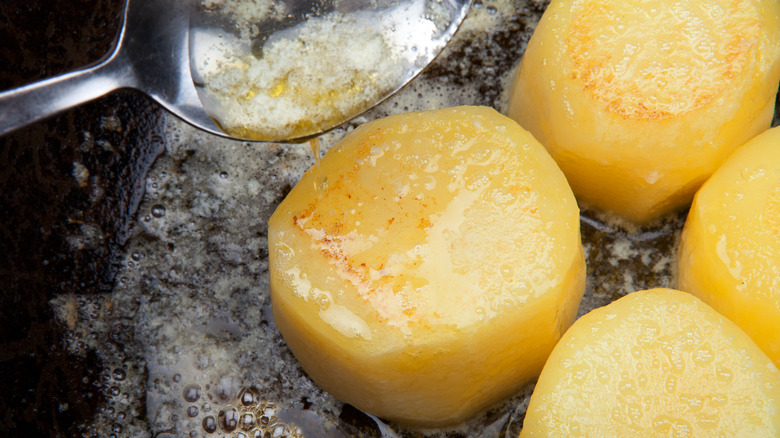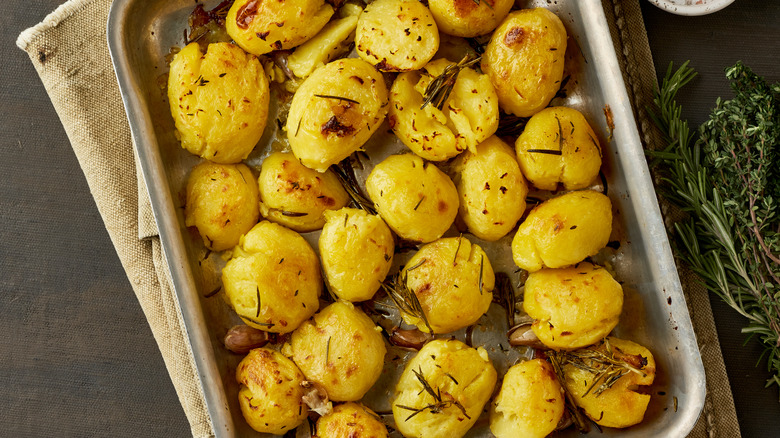10 Tips You Need For Crispier Roasted Potatoes
Roast potatoes are a beloved recipe that have become so much more than just a side dish. For many cooks, they are an essential component of special-occasion meals, from Sunday roast to Thanksgiving dinner and Christmas Eve parties. However, even very simple and familiar recipes can sometimes be easy to mess up. The expectations for roast potatoes are high — if they're not perfectly crispy on the outside and soft and fluffy in the middle, you'll have disappointed guests on your hands. Achieving that balance is not always easy, as one misstep could result in your potatoes being soggy or, worse, burnt.
With so few ingredients in this classic side dish, it's important to get both the components and techniques right in your quest for super crispy roast potatoes. From choosing the right type of spud to arranging them perfectly in the roasting pan, every step plays a crucial part in creating the perfect outer crust and tender interior. Join us as we uncover tried and tested techniques for roast potatoes that are guaranteed to hit the spot every time. Grab your peeler, crank up the oven, and prepare to transform a humble potato into a culinary masterpiece that will have your guests demanding to know your secrets.
Choose the best potatoes
Making the best roast potatoes starts with choose the right type of spud. Not all potatoes are perfectly suited to roasting, so pick the best kind to build the best foundation for your recipe. The secret lies in the starch content: High-starch potatoes will crisp up beautifully on the outside, but they're more delicate and may break down too much under heat. The starch will technically create the crispiest exterior, but you may end up with a tray of crispy mush. Waxy potatoes, on the other hand, will create the perfect soft interior while holding their shape, but may be lacking in crispiness.
For the perfect result, we want a compromise in the form of an "all-rounder" potato. Yukon Gold and Maris Piper are both ideal choices for roast potatoes. Their creamy centers will provide a perfect softness, while the outside will form a lovely golden crust. Both breeds have thin skins, too, so if you can't be bothered to peel them, you will still get nice results.
If you want to push more towards the crispy end of the spectrum and are happy to compromise on the perfect fluffy middle, Russet potatoes, with their high starch content, will give you a satisfying crunch. Either way, be sure to buy the freshest, highest-quality potatoes you can. If the skin feels wrinkled or the spuds are starting to sprout, they will not do your dish justice. By giving a bit of thought to the purchase of your potatoes, it's much more likely to get the golden crunch you are aiming for.
Peel the potatoes
When making perfect roast potatoes, there is one big question that is hotly debated: whether to peel the potatoes or not. There are many great reasons to leave the skins on your potatoes before roasting, starting with flavor. The skins have an earthy taste that creates a rustic flavor that is lacking in peeled potatoes. It can create a lovely contrast to the mild, creamy flavor of the inside, and some people swear that skin-on is the only way to roast your spuds.
From a nutritional standpoint, leaving the skins on makes sense, too. The skin helps to keep vitamins and minerals inside the potato during cooking, so leaving them on will make your dish more nutritious (via Healthline.) Finally, we can't discount the convenience factor — peeling potatoes is fiddly work, and leaving the skins on will reduce preparation time considerably.
However, if your main aim is to improve the crispiness of your roast potatoes, there really is no question: Peeled potatoes crisp up better. By peeling the spuds, you create a rough surface for butter, oil, or any other kind of fat to cling to, which will crisp up nicely as they cook. Any seasonings you add, including coarse salt, will then stick to the fat, which can also add to the crispy texture. Since potato skins are smooth, the uneven surface will be lost if you keep them intact, though the skins will create a unique texture of their own. One final reason to peel the potatoes is the aesthetics. If you are aiming for that classic, perfectly golden look, only peeled potatoes will do.
Cut them to the perfect size
A crucial step for evenly-roasted potatoes is to cut them into the most appropriate size. Though you may normally cut your potatoes into rough chunks and move on, overlooking the importance of size could ruin your chances of perfectly crispy spuds.
If your potatoes are cut too large, the insides will not have cooked properly by the time the outsides are crispy. If you cut them too small, the chance of them drying out or burning will rise considerably. The ideal size is around 4 to 5 centimeters in diameter, to give the best chance of both the inside and outside cooking perfectly. For a classic look, keep the natural shape of the potato, trying not to remove too much of the flesh when peeling.
To make sure all the potatoes cook equally, make an effort to keep them similar in size and shape. Otherwise, you may have a few overdone pieces amongst the golden ones. If you take a few extra minutes at the preparation stage to make sure your potatoes are the right size, the crispiest roast potatoes will be within your grasp.
Parboil the potatoes
Boiling potatoes before you roast them may seem like an unnecessary hassle, since it's much easier to simply chuck them in the oven raw and forget about them until they're done. But parboiling can definitely be worth it if you want fluffy middles and crispy outsides.
Parboiling is a term used to describe the process of semi-cooking ingredients, derived from the words "partial" and "boiling". Cooking potatoes in boiling water starts to break down their starches — which is necessary to achieve crispness — much more quickly than in the oven. When you transfer the chunks to a hot oven, the outside layer can crisp up faster since the starch has already been broken down. It will also reduce the chance of the outsides burning while you wait for the middles to cook.
Parboiling also reduces the overall time your potatoes have to stay in the oven. Although it may feel like parboiling is just adding more work to your recipe, the good news is you can parboil potatoes in advance, even up to a day before. This means if you have a big event to prepare for, such as Thanksgiving or Christmas, there will be less work needed on the day of. When parboiling the potatoes, keep in mind that you only want them to partially cook, usually for no longer than ten minutes. Otherwise, they will lose their shape and be reduced to mush, which is definitely not what we're aiming for.
Create a rough exterior
If you've ever seen a celebrity chef roughly shaking a pan of potatoes during cooking, you may have wondered why. This step can actually be a huge help in achieving a craggy, crunchy exterior on roasted spuds. By "roughing up" the potatoes after they have been parboiled, you will create bumps and dents on the outside, which you may worry will spoil the look of the potatoes. What it actually does is increase the surface area of the potato chunks, meaning that the hot fat will have more places to cling to, causing a crispier coating to form.
When you parboil potatoes, the outside will be softer than the inside, so shaking the pot vigorously after boiling will create a rugged exterior on each potato, providing a much crunchier bite than you would get with smooth taters. In the same way that crinkle-cut chips are crispier due to the increased surface area, your crinkly roast potatoes will provide a more satisfying eating experience. So don't be afraid to give the pan a good shake – your guests will thank you for it!
Choose the best fat for roasting
One factor you may not pay much attention to is the fat you use to roast your potatoes. There are many oils and fats to choose for the job, and everyone will have different opinions on what tastes best, but there are a few contenders that will result in crispier potatoes than the rest.
Goose fat is a popular choice for roast potatoes, especially around Christmastime. Its high smoke point means it can be heated to high temperatures without tasting burnt, so it does a great job of creating a crunchy crust in a hot oven. It has a delicious meaty flavor, too, making it a great choice all around. Duck fat has a similar tasty flavor and crunch-enhancing effect. However, the high saturated fat content in animal fat may make the potatoes taste a bit too greasy for some people, not to mention these fats are harder (but not super challenging) to track down than butter or oil from the supermarket.
For a lighter option, try the more unusual choice of coconut oil. Though solid at room temperature, it will melt as soon as it's heated. Since it's a saturated fat, it gives a beautiful golden crunch with little to no coconut flavor, so long as you don't use unprocessed coconut oil. It will feel less greasy than heavier animal fat. Be aware that it may begin to smoke between 350 to 400 degrees Fahrenheit, so you may wish to turn down the oven if you use this option.
Other popular choices, such as vegetable oil and olive oil, will give you great-tasting roast potatoes too, but they may not turn out as crispy. Ultimately, the best fat will come down to your personal preferences, but goose fat and coconut oil are the best options if the ultimate crispiness is your main goal.
Add a semolina coating
If you want your crispy roast potatoes to stand out from the rest, consider an underrated technique that is guaranteed to increase the impact of their crunch. Coating your spuds in semolina before cooking will create a crust that takes their texture to the next level.
Semolina, a type of flour made from durum wheat, sticks beautifully to parboiled potatoes, creating a crunchy coating that will crisp up even more as the potatoes cook in the hot oil. Its mild, slightly nutty flavor means it will complement the potatoes perfectly without overpowering them. Make sure to toss the chopped potatoes with the flour right after parboiling for the best results.
Take the opportunity to impart even more flavor to the potatoes by adding herbs and seasonings. Mix dried or powdered herbs and spices in a bowl with the semolina before sprinkling over the potatoes to create a light dusting. All that's left is to let the oven work its magic, creating crispy roast potatoes that will be the talk of the dinner table. Just take note that semolina, like many flours, is not gluten-free.
Get the oil hot before cooking
When preparing your potatoes for roasting, you should also prepare the fat you'll use for cooking, or you could end up with disappointingly greasy potatoes. No matter what type of fat you've decided to go with, the temperature is important.
If you've ever cooked a steak in a hot pan, you will be familiar with the satisfying sizzle as the meat hits the hot oil. This lets you know that the outside of the meat has started developing a crust right away. We want the same effect with our roast potatoes. Adding the potatoes to cold oil means they will absorb the oil before cooking has begun, which is likely to make the potatoes greasy rather than crispy. Adding them to scorching hot oil instead means they will begin to crisp up as soon as they hit the baking tray.
The most efficient option is to heat the baking tray with the fat already in it while your potatoes are parboiling. This also means if you have chosen a solid fat, it will melt into a liquid, making it much easier to coat the potatoes with it. Take care, of course, not to splash the fat as you add the potatoes, as this could result in a nasty burn. Coating each potato in the hot oil before returning the pan to the oven will create gloriously crispy roast potatoes.
Baste the spuds in the oven
Once you have prepared your potatoes, parboiled them, and added them to hot fat, you may think your job is done and you can slide them into the oven and forget about them for a while. But you're not quite finished yet! To make sure your roast potatoes are the crispiest they can possibly be, you should baste them in the hot oil at least once during the cooking process.
Basting involves removing the tray from the oven and spooning the hot oil from the pan over each chunk of potato, ideally flipping them over as well. This will ensure that the potatoes cook and crisp up evenly, avoiding the problem of some potatoes winding up burnt and others soggy. Depending on what flavorings you add, those flavors will also be dispersed across the potatoes, meaning the garlic, spices, or herbs you've chosen will be evenly distributed.
You should try to baste your potatoes at least once, at about halfway through the cooking time, though you can do it more often if you have the time. Basting is a simple yet often-overlooked step that can take your spuds from good to mouthwateringly crispy — a result that is definitely worth the minute or so it takes to perform the task.
Choose the best roasting pan
Arranging your potatoes in the roasting pan seems like the easiest step in the whole recipe, but it has everything to do with crispiness. If your roasting tin is overcrowded and the potatoes have no space between them, they will not cook consistently, and you will end up with soggy parts. The heat trapped beneath the potatoes can cause them to steam instead of brown, undoing all the good work you have put into them. So make sure you choose a pan that your potatoes will fit nicely into, with enough space in between each piece.
In terms of material, metal pans made from aluminum or stainless steel are the best options for crispiness, as the metal will heat up quickly and transfer heat onto the bottom of the potatoes more efficiently, allowing them to crisp up on all sides. Choose a shallow tray rather than a deep one to allow the hot air in the oven to circulate better.
If you are cooking for a crowd, you are probably better off roasting your potatoes in two separate trays, rather than trying to squeeze all of them into one dish. And be sure to rotate the pans at least once, to make sure the entire batch of potatoes cooks evenly. Follow these tips, and your family will be talking about your amazing roasted spuds for days after they were served.

